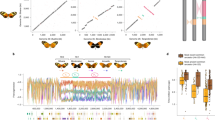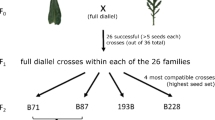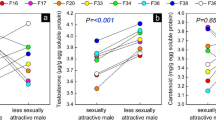Abstract
Levels of outcrossing and self-compatibility were estimated in two populations of Senecio squalidus, a highly successful colonizing species in the U.K. In both populations there was a tendency for outcrossing rate, t, to be depressed below unity in early summer; however, in neither instance was the departure from unity significant. Samples collected in early autumn also exhibited outcrossing rates not significantly different from t=1. Levels of self-compatibility measured in terms of seed set on selfing, were very low in all material tested. This finding plus the results of a crossing programme, provides evidence that British S. squalidus possesses a highly effective self-incompatibility system, most probably of the homomorphic sporophytic type. It is concluded that mating normally occurs at random in British populations of S. squalidus, although some degree of biparental inbreeding may also occur. The latter would cause inbreeding coefficients to exceed zero as recorded in a number of populations previously studied. The ability of S. squalidus to colonize new sites without engaging in uniparental sexual or asexual reproduction is briefly discussed.
Similar content being viewed by others
Article PDF
References
Abbott, R J, Ashton, P A, and Forbes, D G. 1992a. Introgressive origin of the radiate groundsel, Senecio vulgaris L. var. hibernicus Syme; Aat-3 evidence. Heredity, 68, 425–435.
Abbott, R J, Irwin, J A, and Ashton, P A. 1992b. Genetic diversity for esterases in the recently evolved stabilized introgressant, Senecio vulgaris L. var. hibernicus Syme, and its parental taxa S. vulgaris L. var. vulgaris L. and S. squalidus L. Heredity, 68, 547–556.
Barrett, S C H, Morgan, M T, and Husband, B C. 1989. The dissolution of a complex genetic polymorphism: the evolution of self-fertilization in tristylous Eichhornia paniculata (Pontederiaceae). Evolution, 43, 1398–1416.
Barrett, S C H, and Richardson, B J. 1986. Genetic attributes of invading species. In: Groves, R. H. and Burdon, J. J. (eds), Ecology of Biological Invasions: An Australian Perspective Aust Acad Sci Canberra, pp. 21–33.
Barrett, S C H, and Shore, J S. 1987. Variation and evolution of breeding systems in the Turnera ulmifolia L. complex (Turneraceae). Evolution, 41, 340–354.
Brown, A H D. 1979. Enzyme polymorphisms in plant populations. Theor Pop Biol, 15, 1–42.
Brown, A H D. 1990. Genetic characterization of plant mating systems. In: Brown, A. H. D., Clegg, M. T. Kahler, A. L. and Weir, B. S. (eds), Plant Population Genetics, Breeding, and Genetic Resources, Sinauer, MA, pp. 145–162.
Brown, A H D, Burdon, J J, and Jorosz, A M. 1989. Isozyme analysis of plant mating systems. In: Soltis, D. E. and Soltis, P. S. (eds), Isozymes in Plant Biology, Chapman and Hall, London, pp. 73–86.
Brown, A H D, Matheson, A C, and Eldridge, K G. 1975. Estimation of the mating system of Eucalyptus obliqua L'Herit. by using allozyme polymorphisms. Aust J Bot, 23, 931–949.
Clegg, M T. 1980. Measuring plant mating systems. Bioscience, 30, 814–818.
Crowe, L. 1954. Incompatibility in Cosmos bipinnatus. Heredity, 8, 1–11.
Druce, G C. 1927. The Flora of Oxfordshire, 2nd edn. Clarendon Press, Oxford.
Ennos, R A, and Clegg, M T. 1982. Effect of population sub-structuring on estimates of outcrossing in plant populations. Heredity, 48, 283–292.
Gerstel, D U. 1950. Self-incompatibility studies in Guayule II. Inheritance. Genetics, 35, 482–506.
Gibbs, P E, Milne, C, and Vargas Carrillo, M. 1975. Correlation between the breeding system and recombination index in five species of Senecio. New Phytol, 75, 619–626.
Glover, D E, and Barrett, S C H. 1986. Variation in the mating system of Eichhornia paniculata (Spreng.) Solms. (Pontederiaceae). Evolution, 40, 1122–1131.
Gray, A J. 1986. Do invading species have definable genetic characteristics? Phil Trans R Soc Lond B, 314, 655–674.
Hodgkin, T, Lyon, G D, and Dickinson, H G. 1988. Recognition in flowering plants: a comparison of the Brassica self-incompatibility system and plant pathogen interactions. New Phytol, 110, 557–569.
Hughes, M B, and Babcock, D L. 1950. Self-incompatibility in Crepis foetida L. subsp. rhoedaifolia. Genetics, 35, 570–588.
Karron, J D, Marshall, D L, and Oliveras, D M. 1990. Numbers of sporophytic self-incompatibility alleles in populations of wild radish. Theor Appl Genet, 79, 457–460.
Kent, D H. 1955. Scottish records of Senecio squalidus L. Proc Bot Soc Brit Is, 1, 312–313.
Kent, D H. 1956. Senecio squalidus L. in the British Isles. I. Early records (to 1877). Proc Bot Soc Brit Is, 2, 115–118.
Lewis, D. 1979. Sexual Incompatibility in Plants. Arnold, London.
Nei, M, and Syakudo, K. 1955. The estimation of outcrossing in natural populations. Japan J Genet, 33, 46–51.
Ritland, K. 1990. A series of FORTRAN computer programs for estimating plant mating systems. J Hered, 81, 235–237.
Ritland, K, and Jain, S. 1981. A model for the estimation of outcrossing rate and gene frequencies using n independent loci. Heredity, 47, 35–52.
Schoen, D J. 1982. The breeding system of Gilia achilleifolia: variation in floral characteristics and outcrossing rate. Evolution, 36, 352–360.
Uyenoyama, M K. 1986. Inbreeding and the cost of meiosis: the evolution of selfing in populations practising biparental inbreeding. Evolution, 40, 388–404.
Wilson, C. 1991. Outcrossing in the Oxford Ragwort, Senecio squalidus. BSC. Hons. Thesis, University of St. Andrews.
Author information
Authors and Affiliations
Rights and permissions
About this article
Cite this article
Abbott, R., Forbes, D. Outcrossing rate and self-incompatibility in the colonizing species Senecio squalidus. Heredity 71, 155–159 (1993). https://doi.org/10.1038/hdy.1993.119
Received:
Issue date:
DOI: https://doi.org/10.1038/hdy.1993.119
Keywords
This article is cited by
-
Self-incompatibility: a targeted, unexplored pre-fertilization barrier in flower crops of Asteraceae
Journal of Plant Research (2023)
-
Recent hybrid origin and invasion of the British Isles by a self-incompatible species, Oxford ragwort (Senecio squalidus L., Asteraceae)
Biological Invasions (2009)
-
Reproductive isolation of a new hybrid species, Senecio eboracensis Abbott & Lowe (Asteraceae)
Heredity (2004)
-
Population genetics of sporophytic self-incompatibility in Senecio squalidus L. (Asteraceae) II: a spatial autocorrelation approach to determining mating behaviour in the presence of low S allele diversity
Heredity (2003)
-
The population genetics of sporophytic self-incompatibility in Senecio squalidus L. (Asteraceae) I: S allele diversity in a natural population
Heredity (2002)



